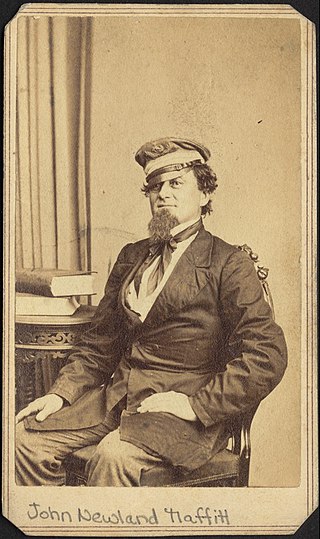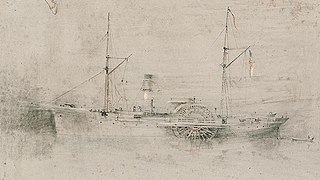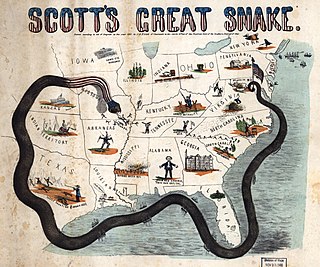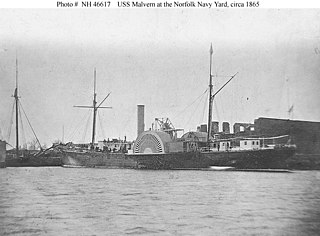
John Newland Maffitt was an officer in the Confederate States Navy who was nicknamed the "Prince of Privateers" due to his success as a blockade runner and commerce raider in the U.S. Civil War.

CSSOwl was a blockade runner in the Confederate States Navy during the American Civil War. It was built by Jones Quiggen, a ship builder in Liverpool, England and launched on June 21, 1864.

CSS Robert E. Lee was a fast paddle-steamer, originally built as a Glasgow-Belfast packet boat named Giraffe, which was bought as a blockade runner for the Confederate States during the American Civil War, then subsequently served in the United States Navy as USS Fort Donelson and in the Chilean Navy as Concepción.

USSKeystone State was a wooden sidewheel steamer that served in the Union Navy during the American Civil War. She was a fast ship for her day and was used effectively to blockade Confederate ports on the Atlantic coast. She participated in the capture or destruction of 17 blockade runners. In addition to her military service, Keystone State had a lengthy commercial career before the war. Renamed San Francisco, she also sailed commercially after the war. The ship was built in 1853 and scrapped in 1874.

USS Fort Jackson was a wooden sidewheel steamer in the United States Navy during the American Civil War. She was successful in enforcing the Union blockade of Confederate ports, capturing five ships carrying contraband. She participated in the battles for Fort Fisher, which effectively closed the port of Wilmington, North Carolina to the Confederacy. Most notably, the surrender of Confederate forces in Texas was signed aboard the ship, formally ending the Civil War in that portion of the country.

USS James Adger was a sidewheel steamer in the Union Navy during the American Civil War. She retained her former name.

The Union blockade in the American Civil War was a naval strategy by the United States to prevent the Confederacy from trading.

The first USS Gettysburg was a steamer in the United States Navy. The ship was built in Glasgow, Scotland, in 1858, named RMS Douglas, and operated by the Isle of Man Steam Packet Company in the United Kingdom between Liverpool, England, and Douglas on the Isle of Man until November 1862. She was then sold to Cunard, Wilson & Company on behalf of the Confederate agents Fraser, Trenholm & Company for use by the Confederate States of America during the American Civil War. Renamed Margaret and Jessie, she operated as a blockade runner until her capture by the Union on 5 November 1863. The ship then was commissioned into the Union Navy on 2 May 1864 as USS Gettysburg.
Thomas Leslie Outerbridge was a notable Bermudian, who participated in the American Civil War as a sailor aboard blockade runner ships from Bermuda.

PS Lelia was a steamship built in 1864, during the American Civil War for use as a blockade runner for the Confederate States of America. She sank in Liverpool Bay in 1865 in an incident that caused 46 fatalities.

Wilmington, North Carolina, was a major port for the Confederacy during the American Civil War. It was the last port to fall to the Union Army, completing its blockade of the Atlantic coast.

USS Quaker City was a heavy, 1,428 long tons (1,451 t) sidewheel steamship leased by the Union Navy at the start of the American Civil War. She was subsequently purchased by the navy, outfitted with a powerful 20-pounder long rifle, and assigned to help enforce the Union blockade of the ports of the Confederate States of America.

USS Grand Gulf was a wooden-hulled, propeller-driven steamer acquired by the Union Navy during the American Civil War. She was effective in performing blockade duty, and captured a number of Confederate blockade runners.

USS Malvern was a large steamer captured by the Union Navy during the American Civil War. She was then used by the Union Navy to patrol navigable waterways of the Confederacy to prevent the South from trading with other countries.
USS Tristram Shandy was a 444-ton steamer and blockade runner captured by the Union Navy during the American Civil War.

USS Bermuda was a large steamer captured by the Union Navy during the American Civil War. She was used by the Union Navy as a cargo and general transport ship in support of the Union Navy blockade of Confederate waterways, primarily in Florida and the Gulf of Mexico. However, despite being a valuable cargo ship, she proved very adept at capturing blockade runners as her record proves.
USS State of Georgia was a large steamer with powerful guns acquired by the Union Navy during the American Civil War. State of Georgia, with her crew of 113 sailors and officers, was used by the Union Navy as a gunboat in its blockade of Confederate waterways.

USS Gertrude was the British blockade-running steamship Gertrude captured by the Union Navy during the American Civil War. She was placed in service by the Navy as a gunboat and assigned to patrol the southern coast of the United States for ships attempting to run the Union blockade of Southern ports. She was later the American merchant ship Gussie Telfair until wrecked in 1880.
The blockade runner Mary Bowers, Captain Jesse DeHorsey, bound from Bermuda to Charleston, South Carolina with an assorted cargo, struck the submerged wreck of the SS Georgiana in fourteen feet of water a mile off of Long Island on August 31, 1864. She "went on with such force as to make immense openings in her bottom," and she sank in a "few minutes, most of the officers and men saving only what they stood in." The steamer's passengers and crew escaped with the exception of a boy, Richard Jackson, who was left on the wreck and later taken off by the Federals.

During the American Civil War, blockade runners were used to get supplies through the Union blockade of the Confederate States of America that extended some 3,500 miles (5,600 km) along the Atlantic and Gulf of Mexico coastlines and the lower Mississippi River. The Confederacy had little industrial capability and could not produce the quantity of arms and other supplies needed to fight against the Union. To meet this need, British investors financed numerous blockade runners that were constructed in the British Isles and were used to import the guns, ordnance and other supplies, in exchange for cotton that the British textile industry needed greatly. To penetrate the blockade, these relatively lightweight shallow draft ships, mostly built in British shipyards and specially designed for speed, but not suited for transporting large quantities of cotton, had to cruise undetected, usually at night, through the Union blockade. The typical blockade runners were privately owned vessels often operating with a letter of marque issued by the Confederate government. If spotted, the blockade runners would attempt to outmaneuver or simply outrun any Union Navy warships on blockade patrol, often successfully.















